The Adhesive Tapes Market size was valued at USD 81.52 billion in 2023 and is expected to hit USD 127.98 billion by 2031. It is estimated to grow at a CAGR of 5.8% over the forecast period 2024-2031.
The adhesive tapes market is experiencing significant growth due to increased demand from industries such as packaging, automotive, healthcare, and electronics is a major driver. Technological advancements leading to the development of high-performance tapes with enhanced properties like temperature resistance, durability, and customization capabilities also contribute to market expansion. Growing awareness about the benefits of adhesive tapes over traditional fastening methods, such as screws and bolts, is another factor driving adoption. Additionally, the rise in e-commerce activities and the need for efficient packaging solutions further propel market growth. Emerging economies witnessing industrialization and infrastructure development are providing lucrative opportunities for market players, fostering growth in the adhesive tapes sector.
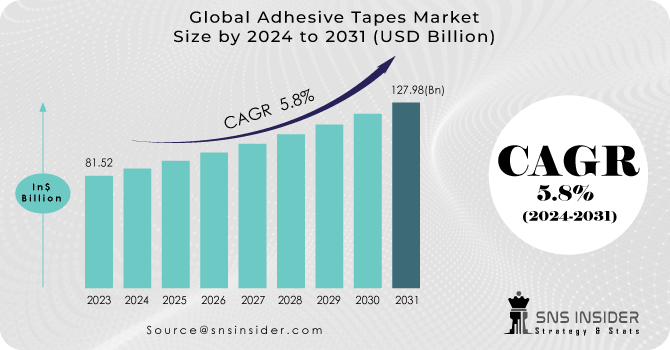
Get More Information on Adhesive Tapes Market - Request Sample Report
In addition, concerns about the environment are leading to a greater demand for adhesive tapes that are eco-friendly, and made from materials that can be recycled. These tapes also use adhesives that don't contain harmful solvents, which helps in achieving sustainability goals. Industries are increasingly adopting lightweighting techniques to make their products lighter, and adhesive tapes are becoming a preferred choice for bonding due to their cost-effectiveness and efficiency. This trend is further boosting the growth of the adhesive tapes market.
Drivers
Technological advancements help to develop high-performance tapes with enhanced properties.
Growing demand from the packaging and construction industry
The packaging industry is a major consumer of adhesive tapes, and its steady growth is a key driver for the adhesive tapes market. E-commerce and the increasing demand for convenience foods are driving the need for strong, reliable, and tamper-evident packaging solutions, which is where adhesive tapes come in. Adhesive tapes are finding increasing use in construction applications such as bonding insulation materials, sealing windows and doors, and adhering carpets and flooring. The growing construction activity in developing economies is another factor propelling the market forward.
Restraint
Volatility in raw material prices
Volatility in raw material prices poses a significant challenge for the adhesive tapes market, as it can lead to uncertain production costs and profit margins. Fluctuations in prices of key raw materials, such as petroleum-based resins or natural rubber, can directly impact the overall manufacturing expenses, potentially affecting pricing strategies and competitiveness in the market. Moreover, sudden price hikes or shortages in raw materials may disrupt supply chains and necessitate adjustments in sourcing strategies, adding complexity to operational planning and management.
Environmental concerns associated with the use of adhesive tapes
Opportunities
Rising preference for eco-friendly tapes
Potential for substitution of traditional fastening systems
Adhesive tapes can offer several advantages over traditional fastening methods such as rivets, screws, and welding, including ease of use, faster assembly times, and improved aesthetics. As manufacturers look for more efficient and cost-effective ways to join materials, the potential for adhesive tapes to substitute traditional methods presents a significant growth opportunity.
Challenges
Regulatory compliance and standards regarding the use of certain adhesive materials.
Intense competition from alternative fastening methods.
Increasing adoption of electric vehicle
Russia and Ukraine are key suppliers of raw materials like wood pulp and chemicals used in adhesives production. The war can disrupt these supplies, leading to shortages and price hikes. Sanctions placed on Russia can limit access to those materials and also inflate energy prices, a key input in adhesive tape production. This has increased production costs and potentially led to price hikes for the final product. The war disproportionately affected certain segments of the adhesive tapes market. For example, the automotive industry, a major user of adhesive tapes, was impacted by sanctions limiting access to car parts manufactured in Russia or Ukraine.
During economic downturns, businesses and consumers tend to tighten their spending. This can lead to decreased demand for adhesive tapes across various industries like construction (due to fewer building projects), manufacturing (due to lower production output), and retail (due to cautious consumer spending). Economic downturns can lead to delays or cancellations of construction and manufacturing projects that rely on adhesive tapes. Economic downturns can lead to disruptions in the global supply chain, impacting the transportation and distribution of adhesive tapes. This can cause delays and shortages, affecting manufacturers and end-users.
The demand for adhesive tapes in essential applications like packaging (particularly for e-commerce) and repairs might remain stable or even see a slight increase during economic downturns. Downturns can push manufacturers to find more cost-effective adhesive tape solutions, potentially driving innovation in material selection and production processes.
By Resin Type
Acrylic
Rubber
Silicone
Others [EVA And Butyl]
The acrylic segment dominated the resin type of adhesive tapes with the highest revenue share of more than 40% in 2023. This dominance is attributed to its exceptional versatility and performance characteristics. Acrylic adhesive tapes offer superior bonding strength, durability, and resistance to UV rays and extreme temperatures. Additionally, they exhibit excellent adhesion to a wide range of substrates, including plastics, metals, and glass, making them highly sought after across various industries such as automotive, electronics, and construction. Their ability to withstand harsh environmental conditions while maintaining adhesive integrity contributes significantly to their widespread usage and market dominance.
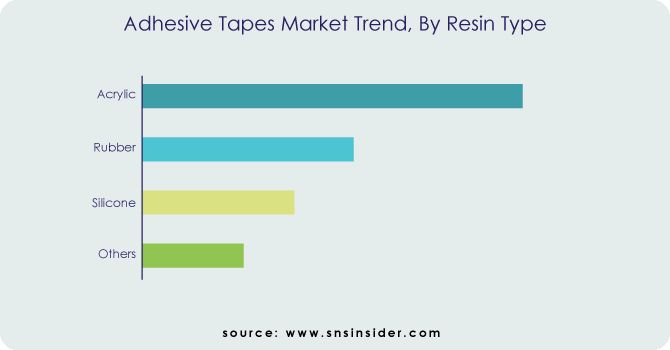
By Backing Material
Paper
Polypropylene (PP)
Polyvinyl Chloride (PVC)
Others
By Technology
Water-Based
Solvent-Based
Hot-Melt Based
Hot-Melt Technology held the largest revenue share of more than 45% in 2023 due to its versatility and efficiency in various applications. Its fast-setting time, strong bonding capabilities, and suitability for a wide range of substrates make it a preferred choice across industries such as packaging, automotive, and construction. Additionally, hot-melt adhesive tapes offer advantages like resistance to temperature fluctuations and moisture, contributing to their widespread adoption and dominance in the market.
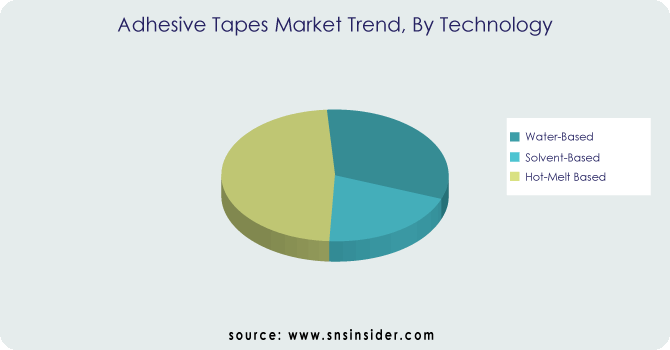
By Category
Commodity Adhesive Tapes
Specialty Adhesive Tapes
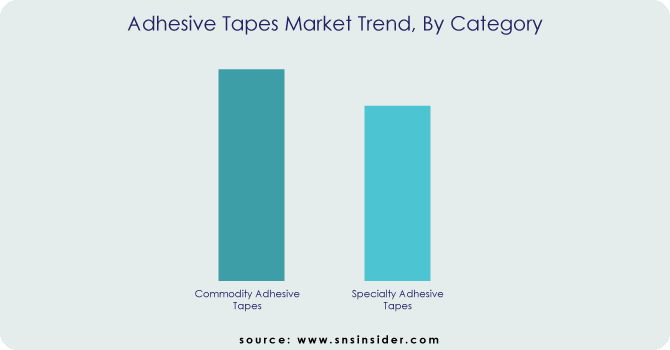
Get Customized Report as per Your Business Requirement - Request For Customized Report
By End-Use Industry
Commodity
Masking
Packaging
Consumer & Office
Industrial
Electrical & Electronics
Paper & Printing
Automotive
Healthcare
Building & Construction
White Goods
Retail
Others
The packaging segment held the largest revenue share in 2023 primarily due to the escalating demand for effective packaging solutions across diverse industries. Adhesive tapes are pivotal in packaging, offering secure sealing and ease of handling, particularly in the booming e-commerce sector. Additionally, advancements in tape technology have enhanced their adhesion and tear resistance, further bolstering their prominence in packaging applications.
Asia Pacific dominated the Adhesive Tapes Market with the highest revenue share of more than 36% in 2023. The region's robust manufacturing sector, especially in countries like China, Japan, and South Korea, drives substantial demand for adhesive tapes across various industries such as electronics, packaging, and automotive industries. Additionally, rapid urbanization and infrastructure development in emerging economies fuel the need for construction and building materials, where adhesive tapes find extensive usage. Moreover, the burgeoning e-commerce sector in the Asia Pacific boosts the demand for packaging materials, further propelling the growth of the adhesive tapes market in the region. Additionally, the presence of key market players and technological advancements in adhesive tape production contribute to Asia Pacific's leading position in the market.
North America held a substantial share of the Adhesive Tapes Market in 2023 and is expected to grow at a significant CAGR during the forecast period. Innovations in tape technology and increasing applications in industries such as electronics and construction further bolster market growth. Moreover, the region's focus on sustainability and stringent quality standards also contribute to the steady expansion of the adhesive tapes market in North America.
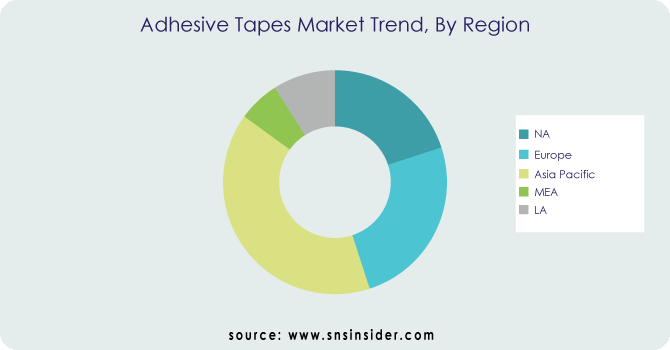
REGIONAL COVERAGE:
North America
US
Canada
Mexico
Europe
Eastern Europe
Poland
Romania
Hungary
Turkey
Rest of Eastern Europe
Western Europe
Germany
France
UK
Italy
Spain
Netherlands
Switzerland
Austria
Rest of Western Europe
Asia Pacific
China
India
Japan
South Korea
Vietnam
Singapore
Australia
Rest of Asia Pacific
Middle East & Africa
Middle East
UAE
Egypt
Saudi Arabia
Qatar
Rest of the Middle East
Africa
Nigeria
South Africa
Rest of Africa
Latin America
Brazil
Argentina
Colombia
Rest of Latin America
Rogers Corporation (US), Berry Global Inc. (US),3M Company (US), Intertape Polymer Group (Canada), Nitto Denko Corporation (Japan), Lintec Corporation (Japan), Scapa Group PLC (Canada), Lohmann GmbH (Germany), Avery Dennison Corporation (US), Tesa SE (Germany).

In February 2024, Rogers Corporation introduced the DeWAL® Plasma X™ tape, the thinnest single-ply masking tape in the DeWAL® thermal spray masking tape product line. It is specifically designed for applications such as plasma spraying, flame spraying, and grit blasting.
In February 2023, 3M released a new medical adhesive that can adhere to the skin for up to 28 days. This breakthrough product is intended for use with various health monitors, sensors, and long-term medical wearables. Before 2022, extended medical adhesives typically lasted up to 14 days, but 3M has now doubled that standard to enhance patient care.
In May 2021, Intertape Polymer Group Inc., a prominent manufacturer of tapes and films, launched a flame-retardant polyethylene (PE) tape known as PEFR.
In April 2021, Schweitzer-Mauduit International, Inc. completed the acquisition of Scapa Group Plc, a UK-based provider of innovative solutions for healthcare and industrial markets. This strategic move has resulted in a newly combined company with annualized sales approaching $1.5 billion.
In 2020, LINTEC developed a new general-purpose permanent hot-melt adhesive to meet the increasing demand for environmentally friendly labels. This adhesive ensures that labels remain securely attached and offers superior adhesion to curved surfaces.
| Report Attributes | Details |
|---|---|
| Market Size in 2023 | US$ 81.52 Billion |
| Market Size by 2031 | US$ 127.98 Billion |
| CAGR | CAGR of 5.8% From 2023 to 2030 |
| Base Year | 2023 |
| Forecast Period | 2024-2031 |
| Historical Data | 2020-2022 |
| Report Scope & Coverage | Market Size, Segments Analysis, Competitive Landscape, Regional Analysis, DROC & SWOT Analysis, Forecast Outlook |
| Key Segments | •By Resin Type (Acrylic, Rubber, Silicone, and Others [EVA And Butyl]) •By Backing Material (Paper, Polypropylene (PP), Polyvinyl Chloride (PVC), and Others) •By Technology (Water-Based, Solvent-Based, and Hot-Melt Based) •By Category (Commodity Adhesive Tapes and Specialty Adhesive Tapes) •By End-Use Industry (Commodity (Masking, Packaging, Consumer & Office), Industrial (Electrical & Electronics, Paper & Printing, Automotive, Healthcare, Building & Construction, White Goods, Retail, and Others)) |
| Regional Analysis/Coverage | North America (US, Canada, Mexico), Europe (Eastern Europe [Poland, Romania, Hungary, Turkey, Rest of Eastern Europe] Western Europe] Germany, France, UK, Italy, Spain, Netherlands, Switzerland, Austria, Rest of Western Europe]), Asia Pacific (China, India, Japan, South Korea, Vietnam, Singapore, Australia, Rest of Asia Pacific), Middle East & Africa (Middle East [UAE, Egypt, Saudi Arabia, Qatar, Rest of Middle East], Africa [Nigeria, South Africa, Rest of Africa], Latin America (Brazil, Argentina, Colombia, Rest of Latin America) |
| Company Profiles | Rogers Corporation (US), Berry Global Inc. (US),3M Company (US), Intertape Polymer Group (Canada), Nitto Denko Corporation (Japan), Lintec Corporation (Japan), Scapa Group PLC (Canada), Lohmann GmbH (Germany), Avery Dennison Corporation (US), Tesa SE (Germany) |
| DRIVERS |
• Technological advancements help to develop high-performance tapes with enhanced properties. • Growing demand from the packaging and construction industry |
| Restraints |
• Volatility in raw material prices •Environmental concerns associated with the use of adhesive tapes |
Ans: The Adhesive Tapes Market was valued at USD 81.52 billion in 2023.
Ans: The expected CAGR of the global Adhesive Tapes Market during the forecast period is 5.8%.
Ans: The primary factors driving the Adhesive Tapes Market include increasing demand from diverse industries such as packaging, automotive, and electronics. Additionally, technological advancements leading to the development of high-performance tapes with enhanced properties and the rising preference for eco-friendly adhesive tapes are significant drivers.
Ans: Opportunities in the Adhesive Tapes Market include the rising preference for eco-friendly tapes made from recyclable materials, aligning with sustainability goals. Additionally, the increasing adoption of lightweighting techniques in various industries presents opportunities for adhesive tapes as cost-effective and efficient bonding solutions.
Ans: Water-based technology is expected to grow at a high CAGR during the forecast period.
TABLE OF CONTENTS
1. Introduction
1.1 Market Definition
1.2 Scope
1.3 Research Assumptions
2. Industry Flowchart
3. Research Methodology
4. Market Dynamics
4.1 Drivers
4.2 Restraints
4.3 Opportunities
4.4 Challenges
5. Impact Analysis
5.1 Impact of Russia-Ukraine Crisis
5.2 Impact of Economic Slowdown on Major Countries
5.2.1 Introduction
5.2.2 United States
5.2.3 Canada
5.2.4 Germany
5.2.5 France
5.2.6 UK
5.2.7 China
5.2.8 Japan
5.2.9 South Korea
5.2.10 India
6. Value Chain Analysis
7. Porter’s 5 Forces Model
8. Pest Analysis
9. Average Selling Price
9.1 North America
9.2 Europe
9.3 Asia Pacific
9.4 Latin America
9.5 Middle East & Africa
10. Adhesive Tapes Market, By Resin Type
10.1 Introduction
10.2 Trend Analysis
10.3 Acrylic
10.4 Rubber
10.5 Silicone
10.6 Others [EVA And Butyl]
11. Adhesive Tapes Market, By Backing Material
11.1 Introduction
11.2 Trend Analysis
11.3 Paper
11.4 Polypropylene (PP)
11.5 Polyvinyl Chloride (PVC)
11.6 Others
12. Adhesive Tapes Market, By Technology
12.1 Introduction
12.2 Trend Analysis
12.3 Water-Based
12.4 Solvent-Based
12.5 Hot-Melt Based
13. Adhesive Tapes Market, By Category
13.1 Introduction
13.2 Trend Analysis
13.3 Commodity Adhesive Tapes
13.4 Specialty Adhesive Tapes
14. Adhesive Tapes Market, By End-Use Industry
14.1 Introduction
14.2 Trend Analysis
14.3 Commodity
14.3.1 Masking
14.3.2 Packaging
14.3.3 Consumer & Office
14.4 Industrial
14.4.1 Electrical & Electronics
14.4.2 Paper & Printing
14.4.3 Automotive
14.4.4 Healthcare
14.4.5 Building & Construction
14.4.6 White Goods
14.4.7 Retail
14.4.8 Others
15. Regional Analysis
15.1 Introduction
15.2 North America
15.2.1 USA
15.2.2 Canada
15.2.3 Mexico
15.3 Europe
15.3.1 Eastern Europe
15.3.1.1 Poland
15.3.1.2 Romania
15.3.1.3 Hungary
15.3.1.4 Turkey
15.3.1.5 Rest of Eastern Europe
15.3.2 Western Europe
15.3.2.1 Germany
15.3.2.2 France
15.3.2.3 UK
15.3.2.4 Italy
15.3.2.5 Spain
15.3.2.6 Netherlands
15.3.2.7 Switzerland
15.3.2.8 Austria
15.3.2.9 Rest of Western Europe
15.4 Asia-Pacific
15.4.1 China
15.4.2 India
15.4.3 Japan
15.4.4 South Korea
15.4.5 Vietnam
15.4.6 Singapore
15.4.7 Australia
15.4.8 Rest of Asia Pacific
15.5 The Middle East & Africa
15.5.1 Middle East
15.5.1.1 UAE
15.5.1.2 Egypt
15.5.1.3 Saudi Arabia
15.5.1.4 Qatar
15.5.1.5 Rest of the Middle East
15.5.2 Africa
15.5.2.1 Nigeria
15.5.2.2 South Africa
15.5.2.3 Rest of Africa
15.6 Latin America
15.6.1 Brazil
15.6.2 Argentina
15.6.3 Colombia
15.6.4 Rest of Latin America
16. Company Profiles
16.1 Rogers Corporation
16.1.1 Company Overview
16.1.2 Financials
16.1.3 Products/ Services Offered
16.1.4 SWOT Analysis
16.1.5 The SNS View
16.2 Berry Global Inc.
16.2.1 Company Overview
16.2.2 Financials
16.2.3 Products/ Services Offered
16.2.4 SWOT Analysis
16.2.5 The SNS View
16.3 3M Company
16.3.1 Company Overview
16.3.2 Financials
16.3.3 Products/ Services Offered
16.3.4 SWOT Analysis
16.3.5 The SNS View
16.4 Intertape Polymer Group
16.4 Company Overview
16.4.2 Financials
16.4.3 Products/ Services Offered
16.4.4 SWOT Analysis
16.4.5 The SNS View
16.5 Nitto Denko Corporation
16.5.1 Company Overview
16.5.2 Financials
16.5.3 Products/ Services Offered
16.5.4 SWOT Analysis
16.5.5 The SNS View
16.6 Lintec Corporation
16.6.1 Company Overview
16.6.2 Financials
16.6.3 Products/ Services Offered
16.6.4 SWOT Analysis
16.6.5 The SNS View
16.7 Scapa Group PLC
16.7.1 Company Overview
16.7.2 Financials
16.7.3 Products/ Services Offered
16.7.4 SWOT Analysis
16.7.5 The SNS View
16.8 Lohmann GmbH
16.8.1 Company Overview
16.8.2 Financials
16.8.3 Products/ Services Offered
16.8.4 SWOT Analysis
16.8.5 The SNS View
16.9 Avery Dennison Corporation
16.9.1 Company Overview
16.9.2 Financials
16.9.3 Products/ Services Offered
16.9.4 SWOT Analysis
16.9.5 The SNS View
16.10 Tesa SE
16.10.1 Company Overview
16.10.2 Financials
16.10.3 Products/ Services Offered
16.10.4 SWOT Analysis
16.10.5 The SNS View
17. Competitive Landscape
17.1 Competitive Benchmarking
17.2 Market Share Analysis
17.3 Recent Developments
17.3.1 Industry News
17.3.2 Company News
17.3.3 Mergers & Acquisitions
18. USE Cases and Best Practices
19. Conclusion
An accurate research report requires proper strategizing as well as implementation. There are multiple factors involved in the completion of good and accurate research report and selecting the best methodology to compete the research is the toughest part. Since the research reports we provide play a crucial role in any company’s decision-making process, therefore we at SNS Insider always believe that we should choose the best method which gives us results closer to reality. This allows us to reach at a stage wherein we can provide our clients best and accurate investment to output ratio.
Each report that we prepare takes a timeframe of 350-400 business hours for production. Starting from the selection of titles through a couple of in-depth brain storming session to the final QC process before uploading our titles on our website we dedicate around 350 working hours. The titles are selected based on their current market cap and the foreseen CAGR and growth.
The 5 steps process:
Step 1: Secondary Research:
Secondary Research or Desk Research is as the name suggests is a research process wherein, we collect data through the readily available information. In this process we use various paid and unpaid databases which our team has access to and gather data through the same. This includes examining of listed companies’ annual reports, Journals, SEC filling etc. Apart from this our team has access to various associations across the globe across different industries. Lastly, we have exchange relationships with various university as well as individual libraries.

Step 2: Primary Research
When we talk about primary research, it is a type of study in which the researchers collect relevant data samples directly, rather than relying on previously collected data. This type of research is focused on gaining content specific facts that can be sued to solve specific problems. Since the collected data is fresh and first hand therefore it makes the study more accurate and genuine.
We at SNS Insider have divided Primary Research into 2 parts.
Part 1 wherein we interview the KOLs of major players as well as the upcoming ones across various geographic regions. This allows us to have their view over the market scenario and acts as an important tool to come closer to the accurate market numbers. As many as 45 paid and unpaid primary interviews are taken from both the demand and supply side of the industry to make sure we land at an accurate judgement and analysis of the market.
This step involves the triangulation of data wherein our team analyses the interview transcripts, online survey responses and observation of on filed participants. The below mentioned chart should give a better understanding of the part 1 of the primary interview.

Part 2: In this part of primary research the data collected via secondary research and the part 1 of the primary research is validated with the interviews from individual consultants and subject matter experts.
Consultants are those set of people who have at least 12 years of experience and expertise within the industry whereas Subject Matter Experts are those with at least 15 years of experience behind their back within the same space. The data with the help of two main processes i.e., FGDs (Focused Group Discussions) and IDs (Individual Discussions). This gives us a 3rd party nonbiased primary view of the market scenario making it a more dependable one while collation of the data pointers.
Step 3: Data Bank Validation
Once all the information is collected via primary and secondary sources, we run that information for data validation. At our intelligence centre our research heads track a lot of information related to the market which includes the quarterly reports, the daily stock prices, and other relevant information. Our data bank server gets updated every fortnight and that is how the information which we collected using our primary and secondary information is revalidated in real time.

Step 4: QA/QC Process
After all the data collection and validation our team does a final level of quality check and quality assurance to get rid of any unwanted or undesired mistakes. This might include but not limited to getting rid of the any typos, duplication of numbers or missing of any important information. The people involved in this process include technical content writers, research heads and graphics people. Once this process is completed the title gets uploader on our platform for our clients to read it.
Step 5: Final QC/QA Process:
This is the last process and comes when the client has ordered the study. In this process a final QA/QC is done before the study is emailed to the client. Since we believe in giving our clients a good experience of our research studies, therefore, to make sure that we do not lack at our end in any way humanly possible we do a final round of quality check and then dispatch the study to the client.
The Chrome Plating Market Size was valued at USD 17.29 billion in 2022, and is expected to reach USD 24.03 billion by 2030, and grow at a CAGR of 4.2% over the forecast period 2023-2030.
The Consumer Foam Market Size was valued at USD 44.1 billion in 2022, and is expected to reach USD 65.15 billion by 2030, and grow at a CAGR of 5.0% over the forecast period 2023-2030
The Construction Chemicals Market was worth USD 41.94 billion in 2022 and is expected to grow to USD 72.06 billion by 2030, with a CAGR of 7.0% in the forecast period.
The Plain bearing Market Size was valued at USD 11.15 billion in 2023 and is expected to reach USD 16.92 billion by 2031 and grow at a CAGR of 5.3% over the forecast period 2024-2031.
The Zero Liquid Discharge Systems Market size was valued at USD 7.26 billion in 2023 and is expected to grow to USD 13.72 billion by 2031 and grow at a CAGR of 8.1% over the forecast period of 2024-2031.
The Squalene Market size was valued at USD 150.26 million in 2023 and is expected to grow to USD 341.24 million by 2031 and grow at a CAGR of 10.8% over the forecast period of 2024-2031.
Hi! Click one of our member below to chat on Phone